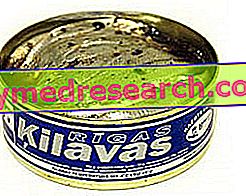Definition and potential preservative
Brine is an aqueous solution of cooking salt (NaCl), the concentration of which is detected by the Baumé densitometer (Bé);

The brines are divided into:
- Desserts (15-18 Bé)
- Forti (20-26 Bé)
The brine must be clear, clear and characterized by a microbial flora represented almost exclusively by halophilic bacteria (which survive in a saline environment), including above all micrococci and Bacillus mesentericus .
Micrococci and Bacilllus mesentericus
The micrococci are aerobic saprophytic bacteria that act coupled two by two (they feed on dead inorganic matter); some of them (NON PATOGENI) participate in the production and maturation of cheeses and fermented sausages.
Bacillus mesentericus, on the other hand, is a harmless bacterium in the brine MA in bread-making products, its excessive fermentation is able to originate a particular alteration known as "stringy bread"; the microorganism, through its own metabolism and its enzymatic action on starch and proteins, determines a viscous matrix, yellow and / or brown, smelly and in fact stringy. This is a contamination that occurs after a few days or in the worst case scenario after a few hours of cooking, especially in large breads that do not reach a sufficient temperature (90-100 ° C) at the heart of the product.
The brine is used both in the production of preserves and in that of the semi-preserves (such as pickled herring) and its use replaces the "salting", even if they are not synonyms since the brine is considerably less dehydrating. This determines that the brine, in light solutions, is used in the short conservation and in the very short one (a few days), for the maintenance of some fishery products waiting for the definitive treatment (smoking or preserves in oil). The use of brine in synergy with other conservative treatments is adopted above all in large pieces that have to undergo a noticeable reduction of free water (activity water - aw) or whose meat has suffered strong trauma during capture and cannot undergo the process conservative with timeliness.
Brine, especially that used in the conservation of highly perishable products (such as fish, meat and sausages), is a treatment that is accompanied by a well-defined climate and environment. Not surprisingly, the above mentioned pickled herring is a semi-preserved product of EXCLUSIVELY Nordic origin, as it is a weak and easily perishable conservative technique due to fermentative and putrefactive processes.
For a successful preservation in brine it is advisable to take several aspects into consideration:
- Strength of the brine: the greater the concentration of salt in the solution, the smaller the penetration time of the same will be inside the product
- Brine contact time: for the same reason, the longer the immersion time will be, the more salt will have the possibility of penetrating the food (continuous but not proportional)
- Volume of brine, or the ratio of brine / product to be preserved (preferably in favor of the volume of liquid)
- Treatment and storage room temperature which should not exceed 15 ° C
In summary, it is advisable to use a strong brine (up to 26 Bé) in the storage of highly perishable products with regard to the greater potential for shelf life.
Maximum Salt Concentration
Why is it not possible to use concentrations of salt higher than the strong brine?
Exceeding the osmotic potential of brine can induce a significant alteration of the preserved product. It is a cellular "osmotic rupture" of muscle fibers (of meat and fish) with respective loss of organic liquids; this results in a reduction in the food yield (and therefore in the weight of the food) and an obvious nutritional impoverishment, without considering the fact that the integrity of the cells is further aggravated by the cooking process.
Preserve the organoleptic properties
Would it be possible to avoid or reduce cellular breakage induced by the pickling process?
It is certainly possible to reduce food spoilage by observing some simple precautions:
- If the food (meat and fish) to be preserved has previously been salted, first partially desalinate it in warm water
- Maintain a meat pH of between 5 and 5.5 (for example, with the addition of food vinegar - acetic acid )
- Use a sweet or medium brine
- Use a low and constant cooking temperature, avoiding thermal shocks: better if under pressure (which favors the penetration of salt)
Nutritional contraindications
As far as the nutritional aspects of preserved foods in brine are concerned, from a macronutritional point of view they are almost unchanged (except for some spontaneous oxidation-peroxidation and hydrolysis processes favored by cooking). On the contrary, if we consider the micronutritional content, we can observe some important differences between fresh and raw products compared to the same cooked and preserved in brine.
First of all, we recall that a "not suitable" preservation method (for example, due to the high temperature) favors the deterioration of the food; secondly, we recall that the aforementioned "cellular rupture" inexorably causes the dispersion of intra-cellular fluids in the preservation liquid. In practice, oxidation and cellular rupture promote the depletion of the product, while poor conservation leads to an alteration of the microflora which favors the organoleptic deterioration of the food.
At the same time, the nutrient that results in excessive doses is sodium (Na) contained in cooking salt (NaCl) added for the preparation of brine. We recall that an excess of dietary sodium in the diet (favored by the consumption of foods stored in brine) is:
- directly related to the onset of arterial hypertension
- potentially implicated (along with other foods or preservation techniques) in the carcinogenesis of the stomach and / or intestines.
In order to reduce the risk of contracting these pathologies it is advisable to avoid the frequent consumption of foods added with salt, therefore also those in brine; this preservation technique was born following the need to favor / prolong the preservability of perishable foods, but following the advent of refrigeration and freezing (heat treatments with cold), it is possible to define that its use in the food industry is actually become of marginal importance.
Bibliography:
- Health and quality control of fishery food products - L. Palese, A. Palese - Piccin - pag 279-280
- Preserved meat - I. Ghinelli - Piccin - pag 529-530



